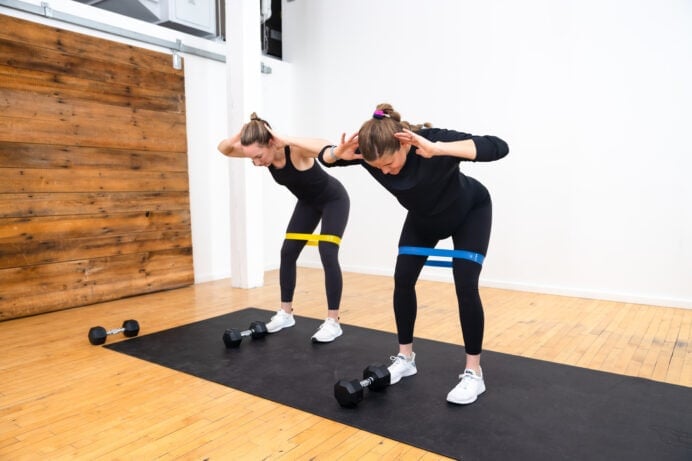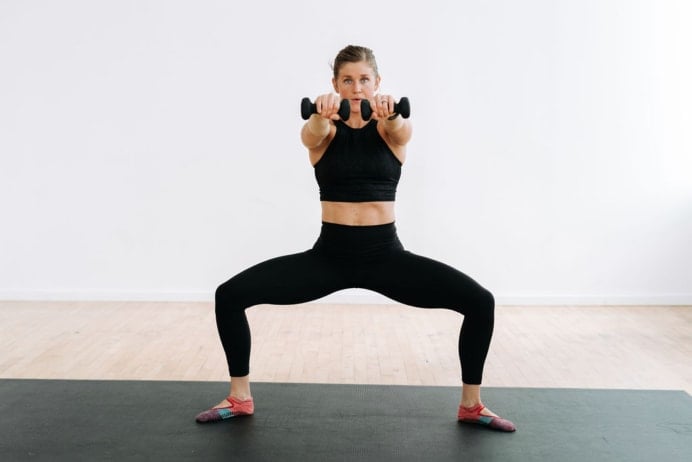

30-Minute First Trimester Workout (Low Impact HIIT)
Stay strong during pregnancy with this low impact prenatal HIIT workout! Nine of the best prenatal HIIT exercises that are safe for early pregnancy and can be carried into the second and third trimesters as well. This 30-minute full body HIIT is a great low impact, but high intensity first trimester workout.
Maintain total body strength and safely challenge your cardiovascular endurance during pregnancy with this first trimester workout.
These 8 prenatal strength exercises and today’s low impact HIIT workout were created specifically for the first trimester. We did this because these workouts:
- Limit up and down motions (movements that can increase nauseousness and morning sickness).
- Include single dumbbell movements (which feels more achievable especially on the days you’re lacking energy)!
- Include modifications (follow modifier Rachel on the left in the videos). You can scale the workout to accommodate how you’re feeling each day AND continue doing these prenatal workouts in your second and third trimesters as well.
This series of first trimester workouts will challenge you to continue to build strength during pregnancy, but in a safe, low impact way.
Find a first trimester workout plan here.

First Trimester Workout FAQs
In general, YES. The American College of Obstetricians and Gynecologists (ACOG) says it’s safe to continue regular exercise during pregnancy. That said, every body (and every pregnancy) is different. Before you begin an exercise program, you should consult your doctor, midwife or health care provider. And listen to your body!
Strength training is the name of the game during pregnancy. This keeps you strong and ready for labor. I also like to include pelvic floor exercises and low impact aerobics like walking, stationary biking, spinning, swimming or water aerobics. Prenatal yoga and prenatal barre/pilates are also popular during pregnancy.
You don’t have to give up high intensity interval training when you’re pregnant, but you might need to slightly modify your HIIT workouts. Increase rest times as needed (the “talk test” is always a great method to abide by during pregnancy workouts). Take low impact modifications. Listen to your body and avoid exercises that might lead to injury or cause pain. Learn more in this post on 5 Exercises to Avoid During Pregnancy and Pregnancy-Safe Modifications.

30-Minute First Trimester Workout (Low Impact HIIT Workout At Home)
Low impact, but high intensity! Nine of the best first trimester HIIT exercises that are safe to carry into your second and third trimesters as well.
A 30-minute prenatal workout at home with the best pregnancy-safe cardio exercises. Hit every muscle group in your body in under 30 minutes!
Add this first trimester workout to your prenatal workout routine 1-2 times a week to maintain strength during pregnancy.
Workout Equipment:
One medium to heavy dumbbell. We are toggling between 15 and 20 lbs in this pregnancy workout.

Workout Instructions:
Follow along with the guided First Trimester HIIT Workout on YouTube, led by certified personal trainer and prenatal fitness instructor, Lindsey Bomgren.
Your Workout Looks Like This:
- 9 Full Body Exercises
- Timed Intervals (40 seconds of work per exercise, 20 seconds rest)
- Repeat All 9 Exercises x2 Sets
Workout Outline
- Squat to Balance Clean
- Single Arm Row and Snatch
- Lunge and Chop
- Single Leg Deadlift and Back Row and Bicep Curl and Press
- Lateral Squat Thruster
- Bird Dog Row
- Army Crawl and Dumbbell Tap
- Glute Bridge and Dumbbell Chest Press
- Lateral Lunge and 2 High Knees

Prefer to Watch On YouTube?
9 First Trimester Exercises (First Trimester HIIT Workout)
Squat and Balance Clean
Targets: Legs, glutes, hamstrings, quads, hips, arms, abs and core.
Squats are a great exercise during pregnancy to maintain strength and range of motion in the hips, glutes, core, and pelvic floor muscles.
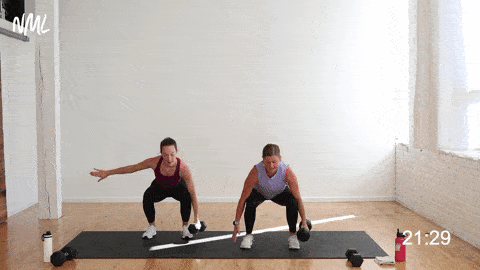
How To Do A Squat and Balance Clean
- Start standing, feet shoulder-width apart, knees slightly bent. Hold one dumbbell in your right hand at your side (palm facing in).
- Sit your hips back as you lower into a squat, striving for a 90-degree angle between your hips and knees.
- Then, drive through your heels to stand tall (legs straight).
- As you stand, bring the dumbbell up towards your chest (this is the “clean” portion of the clean squat). “Catch” the weight at your chest with your other hand.
- As you clean the dumbbell up to chest height, you have the option to add a balance element by driving your right knee towards your chest.
- Lower the dumbbell in your right hand back to the starting position and repeat.
Modification: Follow Rachel on the left and omit the balance knee drive.
Single Arm Row and Snatch
Targets: The legs, hamstrings, hips, glutes, back, shoulders and deep transverse abdomen muscles (core).

How To Do A Single Arm Row and Snatch
- Start standing, feet shoulder-width apart, knees slightly bent. Hold one dumbbell in your right hand at your side (palm facing in).
- Hinge forward at the hips into a bent over row position, neutral spine, flat back from head to tailbone.
- Perform a single arm row by pulling the dumbbell back toward your right hip.
- With control, lower the dumbbell back down in front of you.
- Then, drive your hips forward as you lift the weight up with your right arm (using the momentum created by your legs and hips). Lock out your elbow (arm straight overhead with bicep by ear, palm forward). Note, you shouldn’t struggle to press the weight overhead, it should be an easy extension of the move, with the majority of the work being done by your legs to create momentum.
- With control, lower the dumbbell back down to shoulder height. Then, hinge forward again and repeat the row.
Modification: Follow Rachel on the left, substituting a high pull for the dumbbell snatch.
Lunge and Chop
Targets: The deep transverse abdomens muscles, oblique muscles, legs, glutes, hips, hamstrings, quads, calves, back and shoulders.

How To Do A Lunge and Chop
- Start standing in an athletic stance, feet shoulder-width apart, soft bend in your knees, core engaged. Stagger your feet so your left foot is slightly behind your right. Most of your weight is in your right foot.
- Hold one dumbbell horizontally between your hands.
- Step your left leg back into a reverse lunge, dropping your left knee down towards the ground as you lower your hips until both knees reach a 90-degree angle, front thigh is parallel to the floor. As you lunge, pull the weight back toward your left hip.
- Then drive through your front, right heel and glute to return to a standing position.
- As you stand, use your legs, hips, glutes, abs and obliques to drive the dumbbell crossbody, extending your arms up overhead on the right side. Think left knee to right shoulder. Feet are still hip-width apart with 80% of your weight in your front right foot, and 20% of the weight in your back left toe.
- Lower the dumbbell with control back towards your left knee as you step back into a reverse lunge again.
Modification: Option to perform a modified tap back instead of a reverse lunge.
Single Leg Deadlift and Back Row and Bicep Curl and Shoulder Press
Targets: Legs, hamstrings, glutes, hips, lower back, mid-back, arms, biceps, shoulders, abs and core.

How To Do A Single Leg Deadlift and Back Row and Bicep Curl and Shoulder Press
- Start standing with feet hip-width apart, knees slightly bent. Transfer your weight into your right foot and kickstand or float your left foot off the ground, balancing on your right leg.
- Hold one dumbbell in your left hand (opposite hand as balancing leg), palm facing your body.
- With your right knee bent, hinge at your hips extending your left leg long behind you as you lower the dumbbell down towards the ground, balancing on your right leg. Keep your hips square to the mat. You should feel a good stretch in your right hamstring (back of your right leg) at the bottom of this movement. Range of motion looks different for everyone.
- As you reach this deadlift position, perform a single arm row by pulling the dumbbell back toward your left hip.
- Lower the dumbbell with control, then drive through your front right heel, squeezing your glutes and hamstrings to push your hips forward and return to the starting position. Bring your floating back leg up to meet your standing right leg again.
- As you return to a standing position, perform a single arm hammer curl to single arm shoulder press. Perform a hammer curl on the left arm by bringing the dumbbell up to shoulder height, palm facing in towards your shoulder. Then, press your left arm overhead performing a single arm shoulder press.
- As you perform the single arm shoulder press, you have the option to also perform a knee drive on the left leg.
Modification: Omit the single leg deadlift and knee drive. Instead, perform a staggered stance deadlift and back row.
Lateral Squat Thruster
Targets: Legs, outer glutes (gluteus medius and abductors), quads, inner thighs, chest, shoulders, abs and core.
A great low impact prenatal cardio exercise that will raise your heart rate quickly. If your heart rate gets too high you can avoid the overhead press (hands above the heart).
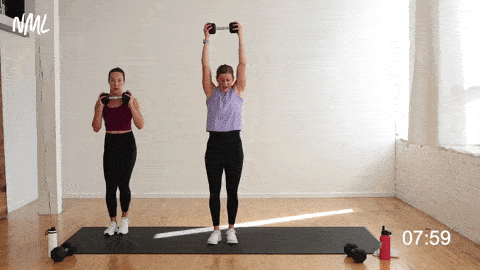
How To Do A Lateral Squat Thruster
- Stand with your feet slightly wider than your hips. Hold one dumbbell at your chest, horizontally.
- Take a lateral step to the right and bend your knees to lower down into a loaded squat position. Weight in heels, chest up.
- Drive through the heels to stand tall, stepping laterally with your left foot to bring it to center with your right foot.
- As you stand tall, drive the dumbbell overhead.
- Repeat this movement, stepping laterally to the right a second time and driving the dumbbell overhead as you stand tall.
- Alternate your lateral movement every two squats.
Modification: Omit the “thruster” or overhead press.
Bird Dog Row
Targets: Upper, mid, and lower back, glutes, hamstrings, abs and core.

How To Do A Bird Dog Row
- Find a quadruped position with your knees hip-width apart and hands firmly on the ground, about shoulder-width apart. Engage your core. Have one dumbbell on the ground in front of your left hand.
- Find a bird dog position by sending your opposite (right) leg back, floating it off the ground.
- Perform a single arm row with your left arm, pulling the dumbbell back toward your left hip.
Modification: Take the row from a quadruped position (in tabletop) rather than from bird dog.
Army Crawl and Dumbbell Tap
Targets: Upper body, shoulders, chest, triceps, back, abs and core.
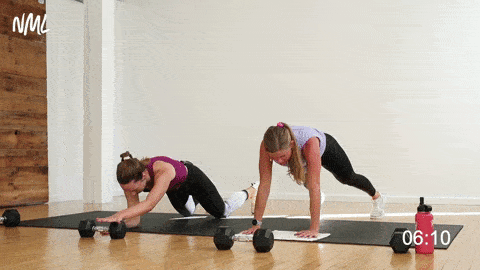
How To Do An Army Crawl and Dumbbell Tap
- Start in a low plank position — forearms on the mat, shoulders stacked over elbows and toes connected to the mat. Straight line from head to tailbone, core engaged. Place a dumbbell on the floor in front of you.
- Reach your left hand out to tap the dumbbell in front of you. Then, return your left forearm to the mat and reach your right hand out to tap the dumbbell in front of you. Return your right forearm to the mat.
- Then, place your left palm on the mat, then your right palm, pushing yourself up into a high plank position.
- Then, lower back down to your forearms. This is an army crawl.
- Once into a low plank position again, reach out to tap the dumbbell.
Modification: Follow Rachel on the left, omitting the army crawl to high plank and staying in a modified low plank position (planking from knees).
Glute Bridge and Dumbbell Chest Press
Targets: Glutes, hamstrings, hips, chest, shoulders, triceps and core.

How To Do A Glute Bridge and Dumbbell Chest Press
- Lie flat on the floor on your back with your knees bent and feet flat on the ground. Hold one dumbbell the long way at your chest.
- Press through the heels to lift your hips off the ground until your knees, hips and shoulders form a straight line. Squeeze the glutes and keep your abs drawn in so you don’t overextend your back during the exercise.
- As you lift your hips off the ground, drive the dumbbell directly overhead.
- Hold your bridged position for a couple of seconds before easing back down.
- With control, lower your hips back to the ground and lower the dumbbell back to your chest.
Modification: Substitute a squat with a dumbbell press out if lying on your back isn’t comfortable.
Lateral Lunge and 2 High Knees
Targets: Gluteus medius (the outer part of your butt used for side-to-side movements), quads, hamstrings, hip adductors and abductors, hip flexors, calves and core.

How To Do A Lateral Lunge and 2 High Knees
- Stand with feet hip-distance apart.
- Step your right leg out to the side as you push your hips back, bending your right knee while leaving your left leg straight. Think of performing a single leg squat with your right leg while your left leg remains straight. Knees and toes are pointing forward.
- Then, drive off your right foot to reverse the movement, exploding back up to center.
- Perform two high knees, driving your left knee up to chest height, then your right knee. Core is engaged.
- Repeat this lateral lunge movement on the right leg; then switch sides for the second set.
Modification: Make this low impact by substituting two knee drives for the high knees.
More Workouts
Pregnancy WorkoutsPin this Workout: 30-Minute First Trimester Workout
Note: Every body and every pregnancy is different. Before you begin an exercise program, especially during pregnancy, you should consult your doctor or midwife. As always listen to your body and avoid exercises that do not feel good for you.
This post includes affiliate links. I do make a small commission for products purchased using these links (at no additional cost to you). Thank you for supporting Nourish Move Love, making the content you see on this blog possible.














